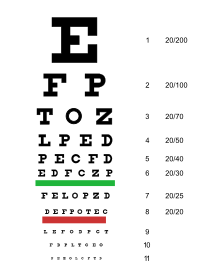Eye chart
 Snellen chart used for visual testing. | |
| Uses | Vision testing |
|---|---|
| Related items | Snellen chart Landolt C Lea test logMAR chart |
An eye chart is a chart used to measure visual acuity. Types of eye charts include the logMAR chart, Snellen chart, Landolt C, and the Lea test.
Procedure
Charts usually display several rows of optotypes (test symbols), each row in a different size. An optotype is a standardized symbol for testing vision. Optotypes can be specially shaped letters, numbers, or geometric symbols.
The person is asked to identify the optotype on the chart, usually starting with large rows and continuing to smaller rows until the optotypes cannot be reliably identified anymore.
Technically speaking, testing visual acuity with an eye chart is a psychophysical measurement that attempts to determine a sensory threshold (see also psychometric function).
Variations
Charts are available for very young children or illiterate adults that do not require letter recognition. One version uses simple pictures or patterns. Others are printed with the block letter "E" turned in different orientations, the so called Tumbling E. The patient simply indicates which direction each "E" is facing. The Landolt C chart is similar: rows have circles with different segments missing, and the test-taker describes where each broken piece is located. The last two kinds of charts also reduce the possibility of the patient guessing the images.
Alternatives
Computer-based semi-automatic alternatives to the eye chart have been developed, but are not very common. They have several potential advantages, such as a more precise measurement and less examiner-induced bias. Some of them are also well suited for children since they resemble a video game.
While visual acuity charts are usually designed for use at 6 meters or 20 feet, there is often also a need to test a subject's vision at near or occupational tasks (like reading or computer use). For these situations near-point charts have been created.
